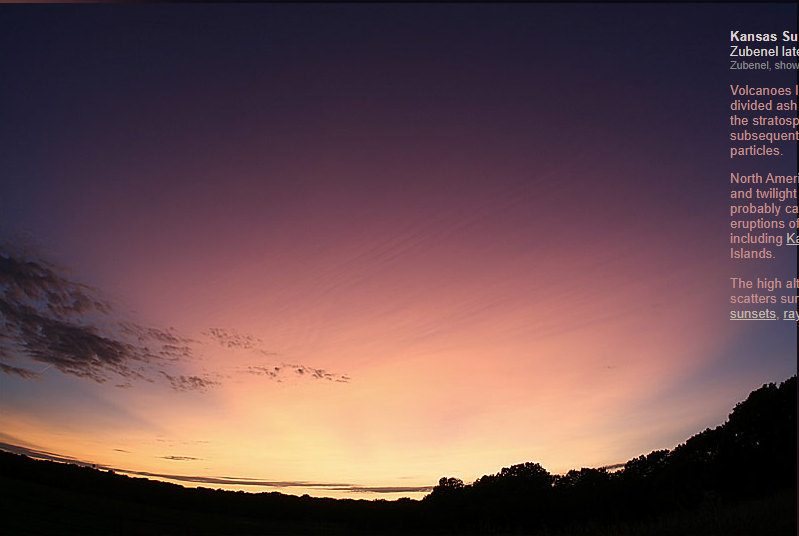Kansas Volcanic Sunset
The Phenomenon of Kansas Volcanic Sunsets
Have you ever witnessed a mesmerizing sunset that seemed to set the sky ablaze with vibrant hues of orange, pink, and purple? While sunsets are often breathtaking, there are times when they take on an even more surreal and awe-inspiring appearance. One such phenomenon is known as the "Kansas Volcanic Sunset." In this article, we will explore the fascinating science behind this natural spectacle and delve into the factors that contribute to its occurrence.
The Influence of Volcanoes on Atmospheric Optics
Volcanic eruptions have a profound impact on our atmosphere. When a volcano erupts, it releases copious amounts of ash and sulfur oxide gases into the stratosphere. These materials then disperse and interact with sunlight, leading to a range of optical phenomena that can be observed from various locations around the globe.
Unveiling the Three Stratovolcanoes
In August of 2008, North America was treated to a series of vivid sunset and twilight skies. These captivating displays were believed to be a result of material ejected from three stratovolcanoes, namely Kasatochi, Okmok, and Cleveland. Located in the Aleutian Islands, these volcanoes had recently experienced eruptions, propelling significant quantities of dust and aerosol particles into the upper atmosphere.
The Role of High Altitude Dust and Aerosols
The fine ash and aerosol particles injected into the stratosphere by volcanic eruptions play a crucial role in creating the mesmerizing Kansas Volcanic Sunsets. At high altitudes, these particles scatter sunlight, resulting in the scattering of shorter wavelengths (blue and green light) more than longer wavelengths (red and orange light). As a result, the sky takes on a stunning array of warm hues during sunset, as these longer wavelengths dominate the scattered light.
Exploring the Glorious Sunsets, Rays, and Bishop's Rings
One of the most striking features of Kansas Volcanic Sunsets is the presence of rays and Bishop's rings. Rays, also known as crepuscular rays or sunbeams, are beams of sunlight that appear to radiate from the position of the setting sun. These rays are formed when sunlight passes through gaps in clouds or other atmospheric obstructions, creating a stunning visual effect. Bishop's rings, on the other hand, are concentric circles of light that surround the sun or moon when viewed through a thin layer of haze or aerosol particles.
The Magic of Scattering
Scattering is the phenomenon responsible for the vivid colors observed during Kansas Volcanic Sunsets. As sunlight interacts with the particles in the atmosphere, it scatters in all directions. However, shorter wavelengths are scattered more effectively than longer wavelengths due to a process known as Rayleigh scattering. This scattering process gives rise to the vibrant blue skies we typically see during the day. However, when dust and aerosol particles are present in the stratosphere, they scatter the longer wavelengths more prominently, resulting in the captivating display of warm colors during sunset.
The Legacy of Kansas Volcanic Sunsets
The occurrence of Kansas Volcanic Sunsets serves as a reminder of the interconnectedness of our planet. Even though these phenomena are triggered by volcanic activity thousands of miles away, their effects can be observed and appreciated by individuals far from the source. They provide us with an opportunity to marvel at the wonders of nature and gain a deeper understanding of how different elements of our environment interact with one another.
In conclusion, the Kansas Volcanic Sunset phenomenon offers a breathtaking display of color and light in the evening sky. Through the scattering of sunlight by high altitude dust and aerosol particles, these sunsets create a spectacle that captivates observers. The interplay between volcanoes, atmospheric optics, and the Earth's atmosphere is a testament to the intricate mechanisms at work in our natural world. So, the next time you find yourself gazing at a mesmerizing sunset, take a moment to appreciate the beauty and scientific marvel unfolding before your eyes.

Kansas Sunset Sky imaged by Doug Zubenel late August '08. Image ©Doug Zubenel, shown with permission.
Volcanoes loft vast tonnages of finely divided ash and sulfur oxide gases into the stratosphere. The sulfur gases subsequently produce aerosol particles.
North America has seen vivid sunset and twilight skies in August. They are probably caused by material from the eruptions of three stratovolcanoes including Kasatochi in the Aleutian Islands.
The high altitude dust and aerosol scatters sunlight to give glorious sunsets, rays and Bishop's rings.
Note: this article has been automatically converted from the old site and may not appear as intended. You can find the original article here.
Reference Atmospheric Optics
If you use any of the definitions, information, or data presented on Atmospheric Optics, please copy the link or reference below to properly credit us as the reference source. Thank you!
-
<a href="https://atoptics.co.uk/blog/kansas-volcanic-sunset/">Kansas Volcanic Sunset</a>
-
"Kansas Volcanic Sunset". Atmospheric Optics. Accessed on April 20, 2024. https://atoptics.co.uk/blog/kansas-volcanic-sunset/.
-
"Kansas Volcanic Sunset". Atmospheric Optics, https://atoptics.co.uk/blog/kansas-volcanic-sunset/. Accessed 20 April, 2024
-
Kansas Volcanic Sunset. Atmospheric Optics. Retrieved from https://atoptics.co.uk/blog/kansas-volcanic-sunset/.